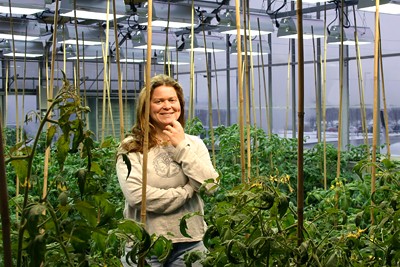Experiment station's 'culture of sustainability' serves as model for campus
By Krishna Ramanujan
The threat of global climate change coupled with Cornell's efforts to reach carbon neutrality by 2050 has got one Cornell unit aiming to serve as a model for change from the bottom up.
The Cornell University Agricultural Experiment Station (CUAES) has adopted a culture of sustainability that welcomes ideas from everyone in the organization.
"We are empowering people by giving them an opportunity to be a part of this [sustainability] cause," said Mike Hoffmann, director of CUAES. "You have to offer all of the citizens an opportunity to do the right thing."
Hoffmann seeks to help catalyze changes across campus in accordance with the American College and University Presidents' Climate Commitment that Cornell President David Skorton signed in 2007, which pledges the university to a path of zero carbon emissions by 2050.
The CUAES has already instigated such changes as using a biodiesel blend in tractors, retrofitting greenhouses with energy-saving light fixtures and stabilizing a creek bank. It is also spearheading a pilot project to cut energy use and the carbon footprint for selected buildings in the College of Agriculture and Life Sciences (CALS).
By offering "top-down support for bottom-up ideas," the unit has created a sustainable action team of 10 people, including greenhouse and farm staff, midlevel supervisors and managers, who brainstorm strategies based on their work experiences and then offer ways to implement their ideas, Hoffmann added.
For example, CUAES, which manages seven research farms and CALS' large greenhouse complex, recently relocated two workers to a campus lab from the Homer C. Thompson Vegetable Research Farm near Freeville so that a large, underutilized building could be shut down for the winter. That move saves thousands of gallons of fuel and $1,500 a month in heating and other costs.
Along with such simple measures as printing on both sides of paper, CUAES staff is also working with the grounds department and horticultural researchers to evaluate grasses that require less mowing than traditional lawns. At the Freeville farm, the staff stopped mowing a hillside and, instead, planted 5,000 mixed hardwood and softwood trees, which, in turn, will sequester carbon from the atmosphere. The farm's staff has also developed new tilling implements that require fewer passes over fields.
This spring, an energy-conservation pilot study in selected CALS buildings will be launched to better understand how human behavior influences energy conservation.
"The pilot project brings to bear the best scientists we have at Cornell to address practical issues we face on campus," said Lauren Chambliss, assistant director for CUAES communications, who leads the effort. "We are designing a low-cost program to motivate behavior change of building residents and empower our community to feel they can do something to reduce costs and help the environment."
Also, CUAES is set to complete a feasibility study for the Cornell University Renewable Bioenergy Initiative (CURBI), an ambitious plan to harness 57 campus waste streams and other biomass resources for generating bioenergy for Cornell's use. CURBI is a component of Skorton's Advanced Sustainability Action Plan and the Cornell Climate Action Plan; it is intended to be a model bioenergy operation for New York state and the country. Once the study is finished, the next step will be to raise $9 million to fund the project.
Get Cornell news delivered right to your inbox.
Subscribe